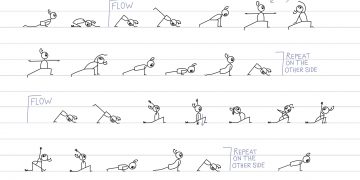We live in a world where human attention is a high-value commodity. Innumerable notifications, dings, and vibrations compete for our attention. Our ability to stay focused has decreased. Humans now have a shorter attention span than goldfish.
Our problems are not especially new. For a long time, people struggled with attention. Fortunately, a significant body of research confirms what yogis knew for thousands of years: yoga improves concentration.
Patanjali famously states the purpose of yoga is to still the changing states of the mind (yogas chitta vritti nirodha). His Yoga Sutras offer practical advice for your spiritual journey, and a necessary aspect of the journey includes reclaiming your attention.

Four Pillars
In yoga communities, one of the most popular methods involves calming the mind to focus on a “meditation object,” such as the breath, a candle flame, or a mantra. These meditation objects support the early stages of the journey. In his system of yoga, often described as “classical yoga,” Patanjali describes four mental states we might experience along the path:
- Awareness of physical objects (vitarka)
- Reflection on the subtle aspects of the objects (vichara)
- Bliss (ananda)
- Absorption with the sense of individuality (asmita)
For instance, with a mantra as your object of focus, the four stages of experience could be:
- You hear the sounds of the mantra
- You reflect on the subtleties of the sounds after repeating the mantra
- You feel a deep sense of joy or bliss
- You move from feeling “I am blissful” to a state of “I am”
Getting beyond the first or second stage can pose a significant challenge. However, for some people those feelings of deep bliss provide motivation to keep doing yoga.
Patanjali’s advice works not just in yoga classes but also outside the studio. We won’t get far along the path if we bliss out during yoga class then act in a vindictive or hateful way the rest of the day. In the Yoga Sutras, Patanjali offers numerous suggestions to help focus and calm the mind (citta prasadanam). I find these practices the most beneficial:
Chanting
Patanjali says repetition (japa) of the sound “OM” leads to freedom from all disturbances. The sound OM is believed to encompass the sound of the entire universe. Studies confirm that chanting, practiced in almost every culture, can boost attention.
With a doctorate in music, I’m drawn to this suggestion because it involves sound.In my yoga classes, people seem less hesitant to chant when I play my harmonium. But anyone can chant OM and you cannot really do it wrong.
Four Immeasurables
To focus the mind, Patanjali recommends cultivating loving-kindness (maitri), compassion (karuna), sympathetic joy (mudita), and equanimity (upeksa). This list corresponds exactly with the four divine abodes (brahma viharas) recommended by the Buddha. These practices are not for “getting rid of distraction.” Rather, these four immeasurables allow us to focus the mind in a beneficial way.
Loving-kindness is a practice of directing goodwill to all people, without exception. One of the most popular and beneficial forms of meditation, people practice loving-kindness with phrases such as, “May I be well, healthy, and peaceful.”
Compassion is loving-kindness for those who are suffering. Sympathetic joy is loving-kindness for those who are happy. Equanimity is not indifference, but rather a stability of mind in all circumstances. We can practice equanimity using phrases like, “this moment is perfect, whole, and complete.”
Breathwork
According to Patanjali, stability of mind can also be gained by controlling the breath (pranayama). We find most of the staple pranayama of the modern yoga class – such as dirgha, ujjayi, nadi shodhana, anuloma viloma, kapalabhati, and bhastrika – in the Hatha Yoga Pradipika. Because Patanjali does not provide a lot of details, many yogis view the Hatha Yoga Pradipika as a “how-to manual” for Patanjali’s recommendations.
Whatever Works
These practices represent a tiny sample of what Patanjali offers. His intentionally flexible system teaches that “steadiness of the mind is attained from meditation upon anything of one’s inclination.” Patanjali provides the base and each of us fills in the details. For example, I experience a special sweetness chanting with my harmonium compared to chanting unaccompanied.
Through practice we discover what works. I found that as I incorporate more of Patanjali’s teaching in my life, I feel more focused, calm, and happy. My motivation comes less from reading Patanjali and more from experiencing the benefits of living according to his teachings. I encourage you to try these practices in your yoga classes and your life.
Matthew is a yoga teacher and musician. He serves on the Board of Directors at onelove.yoga. He leads yoga and meditation classes at the Minnesota Landscape Arboretum, Williston Fitness Center, Minnetonka Community Education, Spirit of the Lake, corporate settings, prisons, and elsewhere. Matthew is an RYT-200 with a Ph.D. in musicology.
















